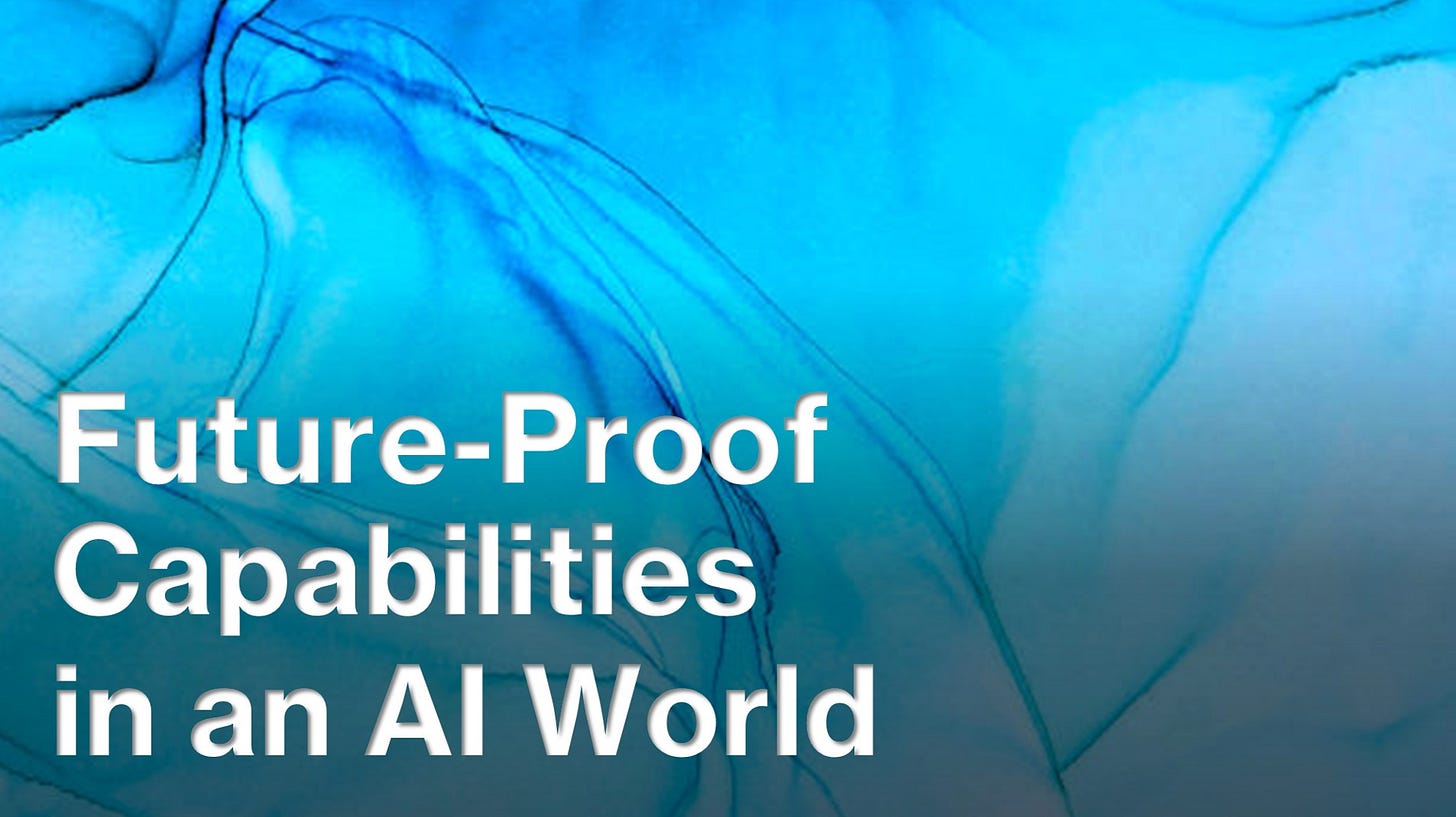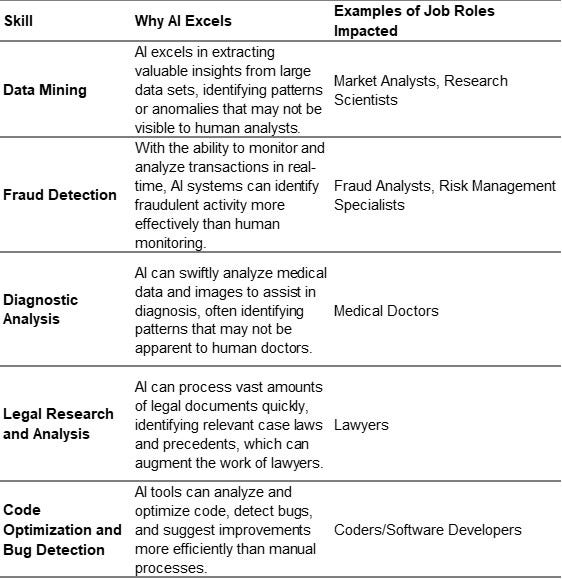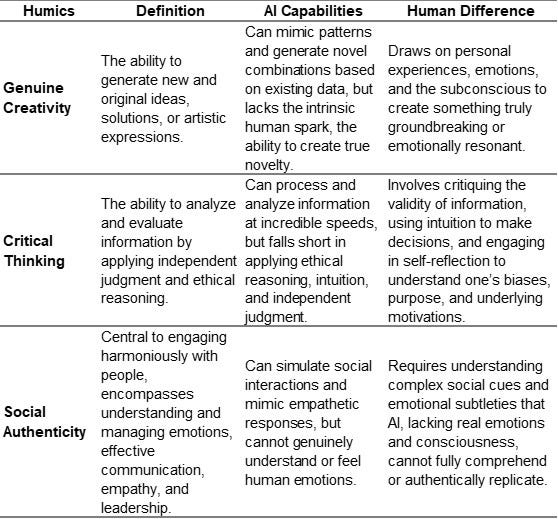Future-Proof Capabilities in an AI World
What capabilities should we build for success in an AI-dominated job market?
In a world where artificial intelligence (AI) excels at technical skills, the uniquely human qualities of genuine creativity, critical thinking, and social authenticity—the Humics—are becoming increasingly valuable. By developing them to the next level, we can create a higher synergy with AI and generate more value for ourselves, our companies, and the world.
This is an abstract from the book IRREPLACEABLE. Please like, comment and share if you appreciate the insight. This is the outcome of years of research at the intersection AI-Human.
Thanks, Pascal
It seems we have lost the battle of skills to AI, correct?
For decades, we've been locked in a constant battle of skills with AI, desperately trying to stay one step ahead. But now, as AI masters even the most complex cognitive tasks, creative endeavors, and decision-making processes, we find ourselves at a critical juncture.
The pace of change is so rapid that we no longer have the luxury of retraining for new roles. The question is not if AI will take our jobs, but when. I believe that to survive and thrive in this new era, we must shift our focus from job security to skill adaptability.
So what is left for humans? Should we focus on developing technical skills, such as the ones of developers, lawyers, and medical doctors?
No, AI masters technical skills better than we do.
The preeminence of AI in technical skills is largely due to its capacity to handle and analyze massive amounts of data much faster than humans, its consistent accuracy in executing routine tasks, and its ability to adapt by learning from new data to enhance its capabilities continuously.
Here are several illustrations:
Is this the end for doctors, lawyers, and programmers?
These roles, as we currently understand them, will drastically change. The skills they require will evolve.
Take doctors, for instance. Their role has largely involved collecting and analyzing data to diagnose patients, making it easy to automate through AI. Soon, our smartphone will provide us with access to an AI doctor available around the clock, surpassing any single doctor worldwide, because it will be trained using the collective knowledge of all doctors from across the globe.
However, the need for human doctors will persist! We will continue to see doctors not for their medical knowledge but for their empathy, communication, advice, and human connection.
How should we evolve our capabilities to avoid being redundant with AI?
To avoid redundancy, we need to build capabilities that complement AI rather than try to compete against it. So, we need to find the areas where AI will never be as good as us.
This matrix demonstrates how AI and human intelligence have complementary strengths and weaknesses.
So in short, human intelligence excels at emotions, subjectivity, authenticity, empathy, true creativity, ethics, and morality… That reminds us something, right?
As we discovered in last week’s newsletter, only one human element withstands the test of time: our deep humanity. It is represented by the Humics, which are the three uniquely human abilities: genuine creativity, critical thinking, and social authenticity.
Why are the Humics important?
Because they are different from what AI can do, the Humics enable us to create synergies with AI. It gives us a roadmap to avoid redundancies. This is when the complementary pair that we form with AI creates a value higher than the sum of the value brought by each party, what we call synergy—when 1+1 = 3.
So understanding, and bringing our Humics to the next level enables us to create the highest value with AI. We will come back into more detail on an action plan to achieve that in future newsletters.
Are you sure that AI will never be able to replace the Humics?
In the face of AI's relentless advancement, we must remain humble. History has shown us time and again that we underestimate AI's potential to master tasks we once thought were uniquely human. Yet, amidst this uncertainty, one thing remains clear: developing our Humics is the wisest thing we can do today.
While AI may simulate more of our capabilities, the full spectrum and depth of the Humics remain beyond its grasp. The Humics are linked to our personality traits, our personal life stories, and our emotions, and to love itself!– aspects that AI, as an artificial construct, will always authentically lack.
Here is a matrix presenting the unique human capabilities compared to AI in the realms of genuine creativity, critical thinking, and social authenticity:
What if AI perfectly mimics the Humics?
Even if AI can replicate the Humics with high fidelity, these capabilities, when exhibited by humans, will always be more valued. The human touch brings an extra dimension of authenticity, emotional depth, and connection that machines cannot duplicate, no matter their level of advancement.
This is the reason why we prefer a human coach to an AI coach to motivate us to get fit, and why we are willing to pay a higher price for a handmade jar compared to one made by a machine.
If AI achieves consciousness and superintelligence, will it master the Humics?
Even if AI reaches superintelligence and consciousness, it will differ from human intelligence and consciousness. Humics are deeply intertwined with human consciousness, shaped by biological evolution, embodied experiences, and social interactions.
Just as humans can never fully develop a dog's intelligence, shaped by its acute sense of smell, AI will never develop the same type of intelligence as humans.
I believe that the only way AI could genuinely replicate the Humics would be through a future merger of humans and AI, creating a new entity blending the human touch with AI's capabilities.
This was an abstract from the book IRREPLACEABLE. Please like and share if you appreciate the insight. This is the outcome of years of research at the intersection AI-Human.
Thanks, Pascal






good stuff pascal
Hmmm. Well I imagine i.e. a thought experiment of encountering a species (bio or not) that has all the higher biological attributes of the other fleshy robots mentioned in this piece plus those of the bonobo and the chimpanzee plus all the tacit and explicit knowledge of Sapiens Sapiens devoured over a certain period of learning. Then add to that the algorithms and self learning. I ponder what levers I could tweak to see different behaviours. I wonder what if there is zero fear or risk adverseness in such a system. You could add 'want' or have zero 'want'. If it just is or if it must become. It gets very very interesting. However what I would really like to see is someone that researches the above angles and premises using real systems under different conditions for 36 months and tell me what they see ;-)